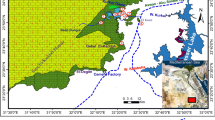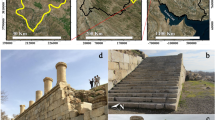Abstract
The microstructure of grainstone, grain-supported limestone, samples representing different geographic and stratigraphic intervals in Egypt were examined before and after calcination at 950°C for 0.25, 0.5, 1 and 2 h. The examination utilized are X-ray diffraction (XRD), X-ray fluorescence (XRF), transmitted light microscopy (TLM), scanning electron microscopy (SEM) and X-ray micro tomography (μ-CT). Both the free lime content and reactivity of the produced quicklime were measured. The quicklime produced at 950°C for 0.25 and 0.5 h is un-reactive (RDIN < 10) due to its low content of free lime. However, quicklime produced at 1 and 2 h conditions is highly reactive (RDIN > 30) with variable reactivity due to the differences in the lime microfabric. The grainstones enriched in nummulites resulted in quicklime of higher reactivity than those dominated by foraminifera, peloids and miliolids. This is mainly attributed to the preservation of the intraparticle pores of the original limestone and the development of pinhole and fracture micropores. The shape of pores and not their amount is the main controlling variable in the quicklime reactivity. The grainstones enriched in fracture pores showed more reactive lime, whereas those with compact structures are less reactive post calcination.







Similar content being viewed by others
References
Abu-zeid MM, Sharaf El-Din AM, Serry MA, Soltan AM (2008) Relative importance and impact of the petrographic components of some Egyptian limestones on quicklime production. Proceedings of the Third International Conference on the Geology of the Tethys: 233–250, Cairo University, Egypt
ASTM Standard C25-06 (2006) Standard test methods for chemical analysis of limestone, quicklime and hydrated lime. ASTM international, West Conshohocken doi:10.1520/c0025-06
Bacelle L, Bosellini A (1965) Diagrammi per la stima visiva della composizione percentuale nelle rocce sedimentary. Ann Univ Ferrara N S Sez IX Sci Geol Paleont 1(3):59–62
Bishay Y (1961) Biostratigraphic study of the Eocene in the Eastern Desert between Samalut and Assiut by the large foraminifera. 3rd Arap Petrol Congress, Alexandria: 7
Boukhary M, Hussein AIM, El-Morcey IA (2002) Eocene larger foraminifera from Helwan, Greater Cairo, Egypt. Rev Micropaléontol 45(1):27–47
Boynton R (1988) The chemistry and technology of lime and limestone, 2nd edn. Wiley, New York
Choquette Ph, Pray L (1970) Geologic nomenclature and classification of porosity in sedimentary carbonates. AAPG Bull 54:207–250
Cnudde V, Cwirzen A, Masschaele B, Jacobs P (2009) Porosity and microstructure characterization of building stones and concretes. Eng Geol 103:76–83
De Graef B, Cnudde V, Dick J, De Belie N, Jacobs P, Verstraete W (2005) A sensitivity study for the visualisation of bacterial weathering of concrete and stone with computerised X-ray microtomography (CT). Sci Total Environ 341:173–183
Dunham RJ (1962) Classification of carbonate rocks according to depositional texture. AAPG Mem 1:108–121
Flügel E (2004) Microfabric of carbonate rocks: analysis, interpretation and applications. Springer, Berlin
Folk RL (1959) Practical petrographical classification of limestones. AAPG Bull 43:1–38
Folk RL (1962) Spectral subdivision of limestone types. AAPG Mem 1:62–84
Friedman GH (1965) Terminology of crystallization textures and fabrics in sedimentary rocks. J Sed Petrol 35(3):643–655
Gheevarhese O, Strydom CA, Potgieter JH, Potgieter SS (2002) The influence of chloride and sulphate ions on the slaking rate of lime derived from different limestone deposits in South Africa. Water SA 28:45–48
Hartman M, Trnka O, Vesely V, Svoboda K (1996) Predicting the rate of thermal decomposition of dolomite. Chem Eng Sci 51:5229–5232
Issawi B, Francis M, Youssef EA, Osman R (2009) The Phanerozoic geology of Egypt, a geodynamic approach. Egyptian Geological Survey and Mining Authority (EGSMA) special publication 81:589
Kantiranis N, Filippidis A, Christaras B, Tsirambides A, Kassoli-Fournaraki A (2003) The role of organic matter of carbonate rocks in the reactivity of the produced quicklime. Mater Struct 36:135–138
Kantiranis N, Tsirambides A, Filippidis A, Christaras B (1999) Technological characteristics of the calcined limestone from Agios Panteleimonas, Macedonia, Greece. Mater Struct 32:546–551
Lech R (2006a) Thermal decomposition of limestone. Part 1: influence of properties on calcinations time. Sil India 71:103–109
Lech R (2006b) Thermal decomposition of limestone. Part 2: influence of contraction, phase concentrations and heating on calcinations time. Sil India 71:110–114
Lech R (2006c) Thermal decomposition of limestone. Part 3: kinetic curves. Sil India 71:143–148
Lech R (2007) Thermal decomposition of limestone. Part 4: permeability of product layer. Sil India 72:110–114
Lech R, Wodricka K, Pedzich Z (2009a) Effect of limestone fabric on the fabric development in burnt lime (Part 1). ZKG Inter 62(6/7):94–101
Lech R, Wodricka K, Pedzich Z (2009b) Effect of limestone fabric on the fabric development in burnt lime (Part 2). ZKG Inter 62(8):63–72
Moropoluoua A, Bakolas A, Aggelakopoulou E (2001) The effect of limestone characteristics and calcination temperature to the reactivity of the quicklime. Cem Concr Res 31:633–639
Moustafa AR (1988) Wrench tectonics in the north Western Desert of Egypt (Abu Roash area, southwest of Cairo). Middle East Research Center, Ain Shams University, Egypt 2:1–16
Oates JA (1998) Lime and limestone: chemistry and technology, production and uses. Wiley–VCH, Weinheim
Paolo D (2002) Properties and reactivity of reactivated calcium-based sorbents. Fuel 81:763–770
Pilkey OH, Morto RW, Lutenauer J (1967) The carbonate fraction of beach and dune sands. Sedimentol 8:311–327
Potgieter JH, Potgieter SS, Moja SS, Mulaba-Bfubiandi A (2002) The standard reactivity test as a measurement of lime’s quality. J South Afr Inst of Mining and Metallurgy 102:67–69
Potgieter JH, Potgieter SS, De Wall D (2003) An empirical study of factors influencing lime slaking Part II: lime constituents and water composition. Water South Afr 29:157–160
Serry MA, Abu Zeid MM, Sharaf El-Din AA, Soltan AM (2008a) Evaluation of Egyptian limestones for quicklime manufacture. Part 1: characterization of technological limestone samples for quicklime manufacture. ZKG Inter 5:68–77
Serry MA, Abu Zeid MM, Sharaf El-Din AA, Soltan AM (2008b) Evaluation of Egyptian limestones for quicklime manufacture. Part 2: factors influencing rate of active-lime liberation of the technological limestone samples. ZKG Inter 6:61–71
Soltan AM (2007) Contribution to the petrography, geochemistry and industrial uses (lime production) of some Egyptian limestones. Ph.D. thesis, Ain Shams University
Soltan AM (2008) Optimum petrographic composition and firing conditions for quicklime production. The 28th Cement and Concrete Science Conference, Manchester University, UK
Soltan AM (2009) Petrographic modeling of Egyptian limestones for quicklime production. Arab J Geosci. doi:10.1007/s12517-009-0095-4
Soltan AM, Hazem M (2009) Quicklime reactivity as a function of limestone microstructure and firing conditions. The 87th Deutsche Mineralogischen Gesellschaft (DMG), Martin-Luther-Universität-Halle-Wittenberg, Germany 238
Stanmore BR, Gilot P (2005) Review—calcination and carbonation of limestone during thermal cycling for CO2 sequestration. Fuel Process Technol 86:1707–1743
Trikkel A, Kuusik R (2003) Modeling of decomposition and sulphation of oil shale carbonates on the basis of natural limestone. Oil Shale 20:491–500
Acknowledgements
The experiments and analyses were made at Bremen University during a 3-month postdoctoral DAAD-GERSS research fellowship. The authors express their deep gratitude to Prof. Dr. Hans Joachim Kuss (Bremen University) Prof. Dr. Mohamed Abu-zeid and Prof. Dr. Mohamed Boukhary (Ain Shams University) for their critical discussion during the implementation of this work. The effort of two anonymous peer-reviewers is also highly appreciated and Associate Editor Anton Beran is thanked for his careful editorial handling.
Author information
Authors and Affiliations
Corresponding author
Additional information
Editorial handling: J. Raith
An erratum to this article can be found at http://dx.doi.org/10.1007/s00710-011-0155-9
Electronic supplementary material
Below is the link to the electronic supplementary material.
Online resource 1
(WLMP 2.18 kb)
Online resource 2
(WLMP 2.16 kb)
Online resource 3
(WLMP 2.17 kb)
Rights and permissions
About this article
Cite this article
Soltan, A.M.M., Kahl, W.A., Hazem, M.M. et al. Thermal microstructural changes of grain-supported limestones. Miner Petrol 103, 9–17 (2011). https://doi.org/10.1007/s00710-011-0151-0
Received:
Accepted:
Published:
Issue Date:
DOI: https://doi.org/10.1007/s00710-011-0151-0




